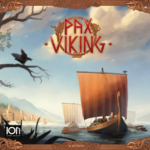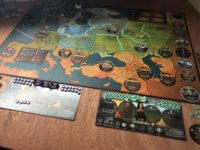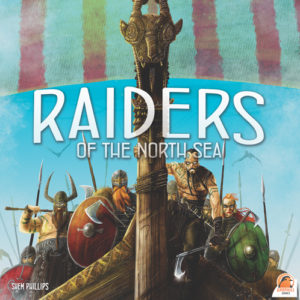- Learning time
- 40 minutes
- First play time
- 150 minutes
Pax Viking
Designed by: Jon Manker
Pax Viking pits the players at each other as viking jarls from the tenth century. There is battle, yes, but this isn’t a game solely comprised of combat. Your jarl will expand, settle, trade, establish advocates and follow Gods of their own choosing. Enough for a decade or six of activity, but Pax Viking crunches it all down into a couple of hours – or less.
The board shows Europe and the Middle East/India as existing or potential viking territory. There is a market of Saga tiles players can buy, and a few more unoccupied on the map itself along with some pre-printed destinations that represent powerful allies or traders. Each player has some silver and a Jarl board populated with four different types of followers – Jarl, Sweden, Theocracy, Rus – and four action tokens. Each turn in the game, you’ll be spending these four actions to further your progress on the board, attempting to establish yourself as the dominant viking jarl. So what are they?
Well, some are straightforward. Journeying is a matter of adding one of your longships to the board and moving it (or moving one already present). Movement is both limited and exhausts your longship until the next turn, so -like much of Pax Viking – timing is critical.
Investing in a saga tile is as simple as paying the price and taking it into your hand. Or you can gamble and take the top tile of the deck for free. Playing is a matter of playing the tile – so let’s pause here and look at what they do. Some tiles are Gods or advocates: these are added to your jarl board giving you some kind of extra power or advantage over the other players. Some are ventures, which can be played to the map, assuming you have one of your longships present to establish it: establishing means placing your followers on the tile to show it’s under your control, and each venture brings it’s own potentially activate-able power – another sling to your bow, as activating such a venture is one of your available actions. And finally event tiles are played for the event written on it – very straightforward, although like all saga tiles, they come with a criteria that must be met to play it. Events can also trigger the end of the game! – we’ll come back to that shortly. There’s one more action to explore, which is parleying. Like establishing, this will gain you control of a particular location on the map, but parleying is Pax Viking’s veiled term for battle: assuming you have more longships present than any opponent, you can eject one of their longships back to their jarl board, and the others to neighbouring regions on the map. Some destinations – such as the powerful allies, who grant you more longships, or trader destinations who supply more cash, also require a cash payment to establish them. Cash is important in the game, and you only get 1 coin at the end of your turn for each type of follower you’ve managed to establish somewhere.
That’s it for the basic actions, but Pax Viking is seeded with risk and reward almost everywhere: having the most of a certain type of follower removed from your board grants you the option of a special action: there are four, each related to the follower type in question. The Jarldom action is a powerful combo of journey and parley rolled into one time-saving action. The Sweden action grants you a free Saga tile, and the possibility of playing it should you draw a venture. The Theocracy action allows you to establish a theocracy follower anywhere legal on the map, ignoring the usual need to have a longship there. And the Rus action allows you to – potentially – steal an advocate from one of your opponents. Grasp and use of these special powers can grant huge power shifts in your direction – although each one can make you enemies as well.
Finally, the game end in Pax Viking can vary from game to game. There are always four possible game-end triggers, but the box gives you twenty to choose from, from the simple (all your Rus followers are established) to the more tricky (two advocates, two ventures, two powerful allies and one God!). Whatever you choose, every time an event tile is played there is a victory check to see if anyone has met the conditions: if they have, they are pronounced best viking!
The guru's verdict

-
Take That!
Take That!
High. This is a game where carefully-laid plans are in continuous danger of a harpoon.
-
Fidget Factor!
Fidget Factor!
Low, although the first play may require some patience as the spinning wheels of potential and mechanics slowly come into focus. Once everyone is up to speed though, even a long wait between turns isn't really down-time as you need to have your eyes peeled on what everyone is doing.
-
Brain Burn!
Brain Burn!
Strategically it's reasonably light - the goals are out there on the board and your actions - how you attain them - are described on your Jarl board. The crunchiness here is the two/three/four/five/six way tactical battle; how almost everything has ramifications on everything else.
-
Again Again!
Again Again!
You need a group of people who enjoy a combative experience and are happy with the manifold possibilities here: things are mechanically simple, but tactically complex, and keeping doggedly to your own interests is an unlikely avenue to victory. It's a game of playing spoiler. Assuming you do, every game varies greatly not just from the fall of the Saga tiles, but the greatest randomizer there is: player input.















Sam says
Yes, it's fairly complex and there are a few things we've not covered here such as Duchies or how players may trade with each other: almost anything they have, including promises to be fulfilled or broken later. On the interactive scale this almost sails its own longship off the chart. Pax games - there are few, although the only other one I've played is Pamir - are interested in two things: telling a story, and pitching the players against each other in almost idiosyncratic fashion. As complex as Pax Viking appears on first sight, it is apparently the most accessible Pax game, and I'd certainly say it's easier to work out what you're doing than my experience with Pamir: although Pamir is more unusual in tone and subject matter, this is mechanically easier to follow. The what-they-heck-ery of combining actions with tiles into a way that feels like a plan is elusive on your first play or two, but I do think - if you like where it's headed - this is worth the time investment. Clever, sinister, sneaky, Pax Viking will eventually stride into view as a deviously nasty multi-player tactical battle.